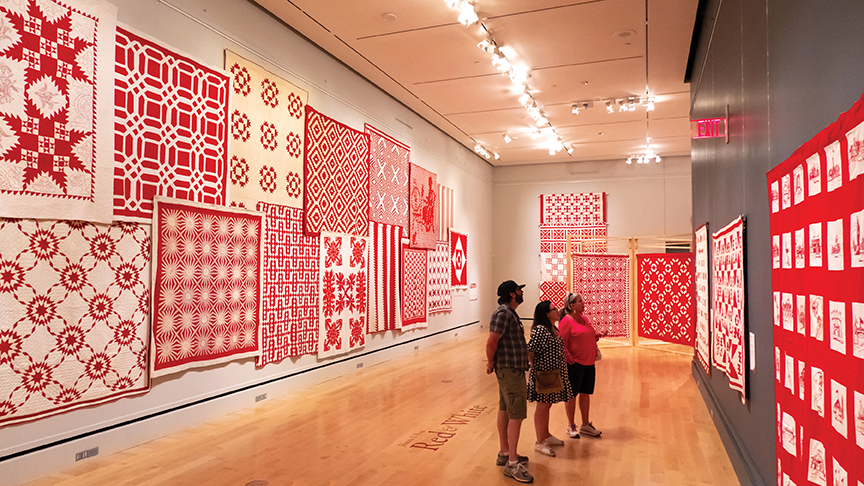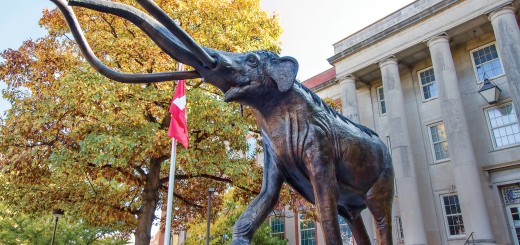More Than fabric & thread

by Patty Beutler
If you think of quilts as only the bed coverings in Granny’s house, think again—and go visit the International Quilt Museum. There you will change your mind; the artistry behind these everyday objects is apparent. You can’t help but appreciate the work that went into making these pieces, some centuries old, preserved and hanging on the walls like canvases in art galleries.
Behind the glass and metal hard edges of the modern building on the University of Nebraska-Lincoln’s East Campus is a gathering of about 6,600 quilts, the largest privately held collection of quilts in the world, right here in Lincoln. The number grows to over 8,000 when it includes quilt-related items.
You don’t have to be a quilt maker or museumgoer to take in the wonder that meets the eye. You glance at the creations on the walls or in boxes and think back to the days when the covers were utilitarian, and fingers worked the tiny stitches by gaslight, piecing scraps of fabric together, without benefit of pattern or store-bought conveniences.
“It’s more than just a visual thing; it really does make you think about the time period and what took place then,” said Leslie Levy, the museum’s director for eight years. “It’s pretty hard to argue that a quilt isn’t art.”
She recalls overhearing a visitor who remarked: “I thought this was a quilt museum; I didn’t know they were hanging paintings.”
Because so many of us grew up with quilts, they are very accessible art, says Levy. “I think quilting is an art form and an expression that is very familiar to people. And because quilts are so familiar to people, they stop seeing them as an art form. We stop seeing what makes them so remarkable.”
But the mastery is still there, whether the antique pieces are utilitarian or the modern offerings are made by recognized artists.
The museum features both historic and contemporary pieces, highlighting the art quilt genre of the 1970s that continues to thrive. Each shows the creativity of individuals, whether working out of necessity or artistic mastery.
Some of the quilters use material you will recognize from your youth—patches of Strawberry Shortcake or Winnie the Pooh fabric purchased at Goodwill from old clothing, curtains and sheets. The familiar takes on a new form.
Quilt makers are the original “upcyclers,” says Levy. Whether using scraps of clothing in past days or discarded textiles in modern times, quilts often turn the mundane into the praise-worthy.
Today’s quilts are made with more than just fabric and thread. They can be any size and made out of anything. Prepare to be surprised!
The art quilt genre often has formally trained artists that are turning to textiles or fabric rather than paint, sculpture or metal. These are not utilitarian quilts, but quilts meant to hang on the wall.
“What we want is to broaden people’s perspective of quilts; we want them to see all the genres; we want them to see historical pieces, we want them to see antique pieces, we want them to see contemporarily made quilts; we have it all. You’re never quite sure what you’re going to see when you walk in.”
A staff of 14 and a volunteer core of 72 keep the museum going, exhibitions rotate every four to six months, so there’s something new to see every two months. A research center and conservation area complete the museum, which also holds various lectures and workshops.
And don’t forget to browse in the gift shop, where fabric swatches and quilting notions join stunning scarves, jewelry and books for purchase.
Visitors on average come from every state and 38 countries. They leave in wonder, promising not to cross the museum off their bucket list because they plan to come back.
“Everyone on our team has the honor of stewarding our collection,” says Levy. “Our goal is to create a global collection and an audience that celebrates the artistic significance of quilts.”
The International Quilt Museum is at 1523 N. 33rd St.
The museum is open Tuesday through Saturday from 10 a.m. to 4 p.m.; closed Sunday and Monday. There is an admission charge except for monthly First Friday activities. Docent tours at 11 a.m. are free with paid admission.
The website is internationalquiltmuseum.org;
402-472-6549
Exhibition Schedule through October 2023
• Uncovering Black History: Quilts from the Collection of Carolyn Mazloomi, through 3/18/23
• Waterworks: The Jack Walsh Collection, through 4/14/23
• Paula Nadelstern: I Am a Patternista, through 4/9/23
• Black Added: Black in Quilts from the Collection, through 3/25/23
• Miami Valley Album Quilts from Sue Cummings Collection: 3/24/23 – 9/2/23
• New Views, International, Geeta Khandelwal: 3/31/23 – 10/14/23
• A New Deal for Quilts: 10/6/23 – 1/16/24














Recent Comments